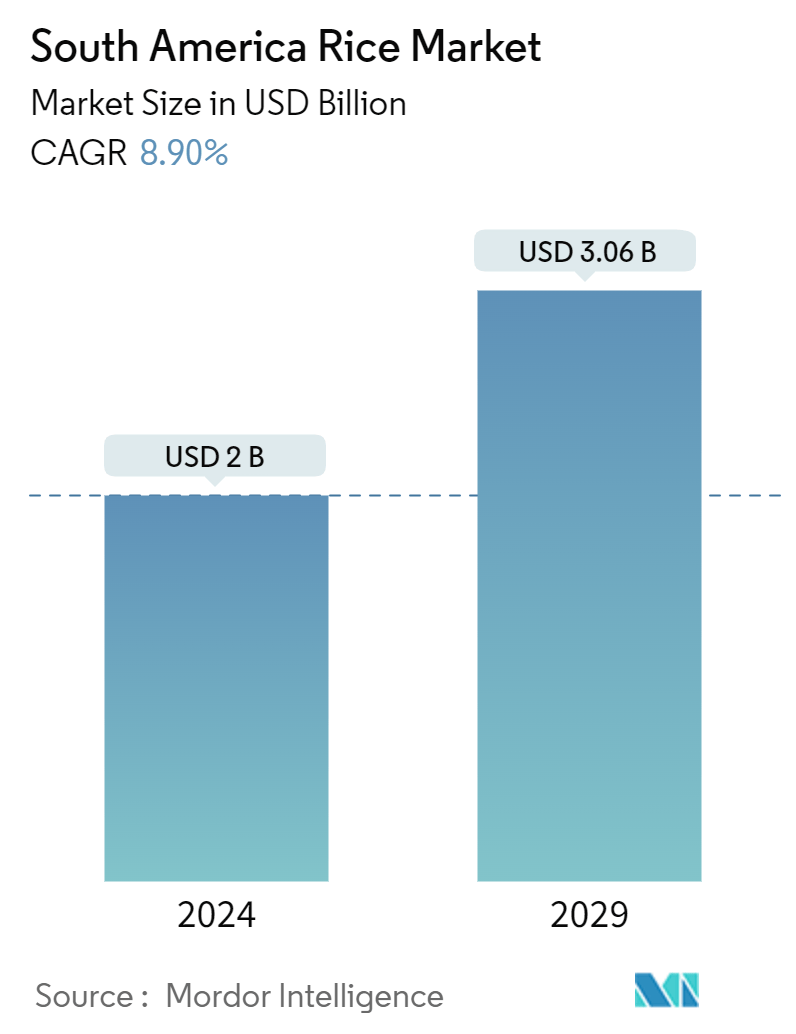Market Size of South America Rice Industry

| Study Period | 2019 - 2029 |
| Base Year For Estimation | 2023 |
| Forecast Data Period | 2024 - 2029 |
| Market Size (2024) | USD 2 Billion |
| Market Size (2029) | USD 3.06 Billion |
| CAGR (2024 - 2029) | 8.90 % |
South America Rice Market Analysis
The South America Rice Market size is estimated at USD 2 billion in 2024, and is expected to reach USD 3.06 billion by 2029, at a CAGR of 8.90% during the forecast period (2024-2029).
- Rice is a major staple crop in most South American countries, primarily cultivated in the region's lowland wet soils. The potential for rice expansion in vast wetlands across Brazil (1.6 million hectares), Andean countries (Bolivia, Ecuador, Peru, and Venezuela), and the River Plate Basin (Argentina, Paraguay, and Uruguay) is expected to significantly influence regional rice production in the future. Tropical countries in the region account for the majority of demand. According to FAO, the rice production area in South America reached 4.0 million hectares in 2022, with Brazil occupying 40% of this area, followed by Colombia at 14%.
- Several South American governments procure food grains, including rice, from farmers to encourage continued agricultural production. Brazil, for example, implements the "Brazilian Scheme of minimum prices of agricultural products." This policy allows the government to purchase certain agricultural products at a fixed minimum price, aiming to reduce rural producers' income fluctuations and ensure national supply stability. In December 2023, the Brazilian government set the minimum purchase price for rice at USD 14.84 per 60 kg bag.
- Brazil's agricultural transformation is driven by several factors: Agricultural research leading to increased yields, expansion of arable land, significant investments in production technologies for crop and forage variety development, and increased global demand for food and animal feed, particularly over the last decade. These factors are expected to contribute to market growth during the forecast period.
South America Rice Industry Segmentation
Rice, the grain derived from the annual marsh grass Oryza sativa, is cultivated in warm climates and serves as a primary food source. In South America, it holds significant economic importance as a major staple crop. The South American rice market is geographically segmented into Brazil, Argentina, Uruguay, Chile, Peru, and the Rest of South America. The market report provides comprehensive analyses, including production analysis (volume), consumption analysis (value and volume), export analysis (value and volume), import analysis (value and volume), and price trend analysis. The report presents market size and forecast data in both value (USD) and volume (metric tons).
| Geography (Production Analysis (Volume), Consumption Analysis (Value & Volume), Import Analysis (Value & Volume), Export Analysis (Value & Volume) and Wholesale Price Trend Analysis) | |
| Brazil | |
| Argentina | |
| Chile | |
| Peru | |
| Rest of South America |
South America Rice Market Size Summary
The South American rice market is poised for steady growth, driven by the region's favorable climatic conditions and agricultural advancements. Rice serves as a crucial staple crop, particularly in tropical countries like Brazil, Peru, Colombia, and Ecuador. The expansion of lowland rice cultivation in Brazil and other regions, coupled with increased global demand for food and animal feed, is expected to bolster production. Brazil, as the largest producer and exporter, plays a pivotal role in the market, supported by significant investments in agricultural research and technology. The country's strategic partnerships, such as with Mercosur, aim to enhance its position as a global rice exporting hub, further driving market growth.
Despite being a net importer, South America's rice consumption has surged, making it the fastest-growing staple food in the region. The adoption of modern, climate-resilient rice varieties has improved production efficiency, catering to the rising demand. Rice is a vital protein source for the region's poorest populations, accounting for a significant portion of their diet. The market's expansion is also supported by Brazil's ability to increase agricultural productivity and its role as a major supplier to international markets. As the region continues to leverage its agricultural potential, the rice market is expected to experience sustained growth over the forecast period.
South America Rice Market Size - Table of Contents
-
1. MARKET DYNAMICS
-
1.1 Market Overview
-
1.2 Market Drivers
-
1.2.1 Increasing Rice Productivity is Boosting the Market
-
1.2.2 Rising Exports in the Region
-
1.2.3 Government Support and Agricultural Policies
-
-
1.3 Market Restraints
-
1.3.1 Climate Change and Weather Related Risks
-
1.3.2 Competition from Other Staple Crops
-
-
1.4 Value Chain Analysis
-
-
2. MARKET SEGMENTATION
-
2.1 Geography (Production Analysis (Volume), Consumption Analysis (Value & Volume), Import Analysis (Value & Volume), Export Analysis (Value & Volume) and Wholesale Price Trend Analysis)
-
2.1.1 Brazil
-
2.1.2 Argentina
-
2.1.3 Chile
-
2.1.4 Peru
-
2.1.5 Rest of South America
-
-
South America Rice Market Size FAQs
How big is the South America Rice Market?
The South America Rice Market size is expected to reach USD 2 billion in 2024 and grow at a CAGR of 8.90% to reach USD 3.06 billion by 2029.
What is the current South America Rice Market size?
In 2024, the South America Rice Market size is expected to reach USD 2 billion.

